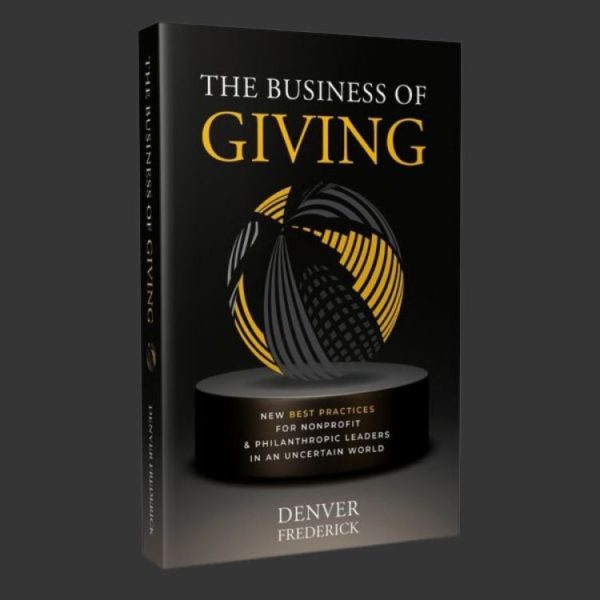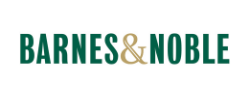Available Now!
Be the exceptional nonprofit leader your organization needs to thrive and make a difference today.
The Business of Giving is every nonprofit leader’s master class for successfully navigating turbulent social and economic times. In addition to providing fresh, actionable ideas, it will validate much of what you and your team are already doing. Read it now to make quick, sound decisions about your increasingly complex management challenges.

Dive into the chapter topics in The Business of Giving:
PART I: TOMORROW WILL BE DIFFERENT
Chapter 1: Leading Through Complexity
A complicated world with difficult problems to solve has become a complex one where problems seem unsolvable. Whether you lead an organization or manage a team, a whole new mindset and set of skills is required to lead through this complexity. Contributions from the CEOs of Malala Fund, Draper Richards Kaplan, Heifer International, American Red Cross, Girltrek, New York Philharmonic, Springboard Collaborative and others.
Chapter 2: Solving the Right Problem
Problem Solving is what leaders do. But how can we be sure we’re solving the right problem? Who solves the problem? And how can we do it better? Subject experts weigh in on these questions and provide a suggested structure and methodology for nonprofit leaders. Additional contributions from the CEOs of Community Solutions, Tostan, Share Our Strength, Simprints and DREAM.
Chapter 3: Decision Hygiene
Bold moves in a crisis are critical. Subject experts address how bias, noise and context impact decision-making and the steps you can take to improve yours. Additional insights on decision making are offered by the CEOs of Komen, American Cancer Society, ideas42, MasterCard Inclusive Growth, StrongMinds and the American Heart Association.
Chapter 4: The Board: Create Stability and Manage Change
This chapter addresses the role of a Board Member, the importance of the relationship between the Board Chair and CEO, maintaining financial stability in the midst of continuing crisises, and how to successfully bring change to your organization. CEOs featured include the Ford Foundation, , Metropolitan Museum of Art, Habitat for Humanity, BoardSource, Humanity United, Girls, Inc. and Ronald McDonald House Charities.
PART II: THE SOFT STUFF IS THE HARD STUFF
Chapter 5: Inner Work
Radical self-inquiry might just be one of the most important practices leaders can develop to keep themselves—and therefore the organization—in a healthy place. The chapter addresses the benefits of inner work, imposter syndrome, burnout and wellbeing for you and your team. Perspectives include those of the the CEOs from Reboot, Synergos, Heron Foundation, Blue Meridian and the Wellbeing Project.
Chapter 6: It’s Not What You Say, It’s What They Hear
Two things leaders must do to be effective communicators is be intentional and be organic. This chapter draws heavily on experts who provide tips on using language effectively, asking the right kind of questions that promote authentic dialogue, and the importance of context and place to communication. Among the organizations featured are Kiva, B Corps, the WISE Fund, Ronald McDonald House Charities, GiveWell and Year Up.
Chapter 7: Meaningful Connections
The key to being a good leader with a strong, engaged team comes down to the three Cs: caring, coaching, and connection. This chapter provides examples of what leaders and managers are doing, as well as what they have learned over the past 3 years. Among the CEOs featured are New Story Charity, Kessler Foundation, St. Jude (ALSAC), and CECP.
Chapter 8: DEIB: A Continuous Journey
Racism is an underlying force that pushes society in a certain direction. Organizations can start to work against the stream by ensuring they focus on diversity, equity, and inclusion efforts. This chapter offers insight from experts in the field as well as viewpoints on inclusion from leaders at ProInspire, YMCA, PolicyLink, Hispanics in Philanthropy, Amani Global Works, NTEN, and others.
PART III: YOUR ORGANIZATION’S CHECK-UP
Chapter 9: Innovation
There’s Always Another Version Innovation can’t happen without a thorough examination of organizational assumptions, a fearless pursuit of the audacious goal at every level, openness to diverse perspectives, analogous research, testing with data, quick acceptance of failure, and prominent identification and recognition of success. This chapter examines all that with the help of the World Wildlife Fund, charity:water, Imaginable Futures, Namati, and Population Services International.
Chapter 10: What’s Your Digital Age?
With how fast things change in the world, the most important thing a nonprofit can do to ensure its survival is to adapt—and that can only happen if technology is at the heart of the organization. The chapter examines what sets tech nonprofits apart, data for social good, best practices for delivering your program virtually, and more. Some of the nonprofits mentioned are DataKind, Beyond 12, SIRUM, Fast Forward, Khan Academy, and Games for Change.
Chapter 11: Trust, Transparency, and your Team
You may have all the technological bells and whistles, big donor money and efficient systems, but if you don’t have trust, transparency, and teams, you won’t get very far, and you won’t get much done. We examine this with subject experts as well as the CEOs of One Love, Freedom Fund, LaunchCode, Sesame Workshop, and Street Business School.
Chapter 12: Scaling for Impact
It’s easy to get excited about shiny, new ideas. Innovation makes people feel hopeful. But how much does innovation matter if organizations can’t figure out how to scale—meaning to grow and replicate—their ideas to increase their impact? Some of the best practices are offered here from the leaders of Spring Impact, Mulago Foundation, LavaMaeX, Rippleworks, New America and Vision Spring.
PART IV: THE MONEY TRAIL
Chapter 13: Shifting Power
As the COVID-19 pandemic forced nonprofits across the country to get creative, it also revealed some of the biggest pitfalls to the way nonprofits and their funders have traditionally functioned. This chapter addresses the disparities and inequities that exist and what is being done – and still needs to be done- to address them. The ideas from the CEOs of the Hartford Foundation, Monitor Institute, Common Future, Robert Sterling Clark Foundation, Blood:Water and the Whitman Institute, are presented.
Chapter 14: Financing the Mission
Fundraising is obviously a huge topic, but we’ll talk about a handful of important developments here, including the impact of COVID-19, the importance of branding, the acceleration of online giving, AI and fundraising, major gift solicitation done virtually, virtual and hybrid galas, cryptocurrency, and timeless advice. Contributors include Against Malaria Foundation, Classy, CharityBuzz, Tiltify, Giving Block and She’s the First.
Chapter 15: Impact Investing
Impact investing came from a recognition that the way we were traditionally solving the world’s problems, through government efforts and philanthropy alone, was insufficient for the nature of inequality and climate change and all the other issues we’re facing around the world. This chapter will provide readers with a snapshot of this field through the the lens of the CEOs of the Global Impact Investing Network (GIIN), ImpactAssets, US Impact Investing Alliance, Kapor Capital, Blue Haven Initiatve, and the Acumen Fund.
Chapter 16: Initiatives Gaining Traction
As the landscape of giving continues to change, it’s worth examining initiatives that are gaining traction. One common thread is a general shift toward democratizing and decentralizing the way funds are raised, distributed, and used. Topics covered include Giving Circles, Mutual Aid Societies, Pooled Funds, Collaboratives, Social Impact Bonds and Donor-Advised Funds. Leaders from Philanthropy Together, One for Democacy, Social Finance Black Benefectors, JDRF, and GiveDirectly are included.
PART V: SO WHAT COMES NEXT?
Chapter 17: Righting Past Wrongs
This chapter discusses what it means to be anti-racist, the impact of systemic and historical racism, and what we can do about it. Tackling racial injustice, inequality, and equity in funding is something all nonprofit leaders must bake into the very fundamentals of their organization. The chapter features the CEOs of the Annie E. Casey Foundation, Echoing Green, Bridgespan Group, PolicyLink, Upsolve and the Libra Foundation.
Chapter 18: Rewriting the Social Contract
Philanthropy is concerned with creating a fair, just, and equitable society. While that often means challenging the system and working to address its flaws, we nevertheless do work within the parameters of that system. And that system, of course, is capitalism. Today’s thought leaders suggest we reimagine the system if we want to ultimately accomplish our goals. The ideas in this chapter are offered by the CEOs of the Hewlett Foundation, Omidyar Network, Kickstarter, the Roosevelt Institute, Global Citizen Year and JUST Capital.
Chapter 19: Under the Hood
To create deep, lasting social change is an incredibly complex task. No one person or organization can do it alone. To truly tackle issues such as poverty, health disparities, education gaps, and more will take serious reconfiguration of policies, power structures, and processes. In other words, systems change. The best thinkers on systems change from institutions such as Collective Change Lab, New Profit, Schwab Foundation for Social Entrepreneurship, Catalyst 2030 and Think of Us weigh in.
Chapter 20: Your Napster Moment
In 1999, a teenager and a relatively simple piece of technology that allowed file sharing, rocked the music industry. It has become known as the “Napster Moment.” Many organizations in the Philanthropic and Nonprofit sector are experiencing their Napster Moment right now. And so are many of its leaders. This chapter poses questions about your organization and your own leadership. Please pause and reflect upon them.
In The Business of Giving,
You’ll Learn How To:
Significantly improve your organization’s problem-solving capacity
Step up to become the ultimate “sense maker” for your team or organization
Build a culture of innovation where new ideas come from everywhere
Master scaling to create maximum impact
Communicate intentionally and organically with others
And many more!
Get insightful tips on leadership, innovation, systems change, power sharing, and other relevant nonprofit matters delivered to your inbox.

HI, I’M DENVER
Radio Show Host, Speaker, Moderator, and Executive Coach
Denver Frederick is a trusted advisor and executive coach to nonprofit CEOs, acting as a comprehensive resource, confidant, and consultant. In his 40-plus years in the nonprofit sector, he has served as a CEO, led the fundraising campaign to restore the Statue of Liberty and Ellis Island, assisted renowned actor Michael J. Fox in launching his Parkinson’s foundation, and pioneered the movement of peer-to-peer fundraising.
For the past 10 years, Denver has hosted The Business of Giving, a nationally syndicated radio show turned podcast. In nearly 1,000 interviews with nonprofit CEOs and subject experts, he’s revealed their challenges and the innovative solutions comprising new best practices for social impact organizations. He’s also conducted over 150 team focus groups to surface the “secret sauce” of organizational cultures that makes them irresistible places to work.
Denver has taught at the NYU School of Fundraising Management and is a certified professional executive coach. He is a sought-after speaker who has appeared at forums such as the Harvard Social Enterprise Conference and the Citi Foundation Annual Convening of Grantees and Partners.


